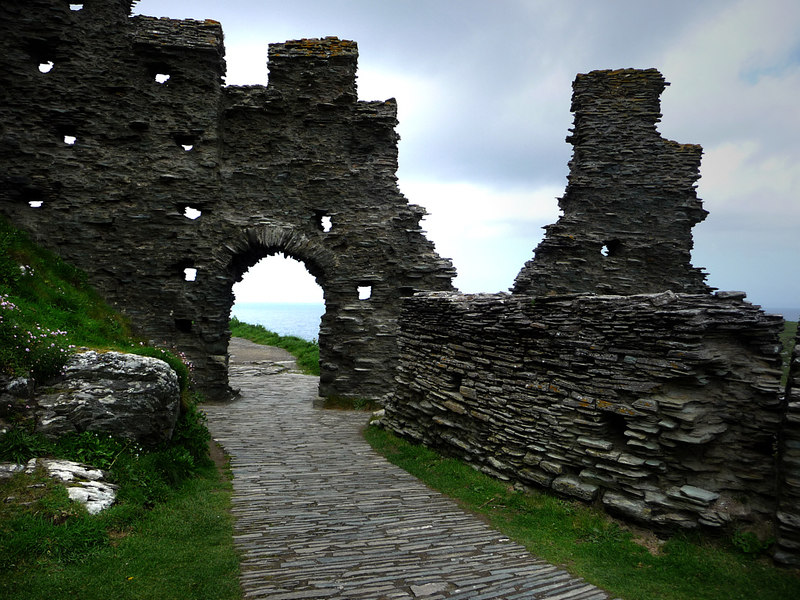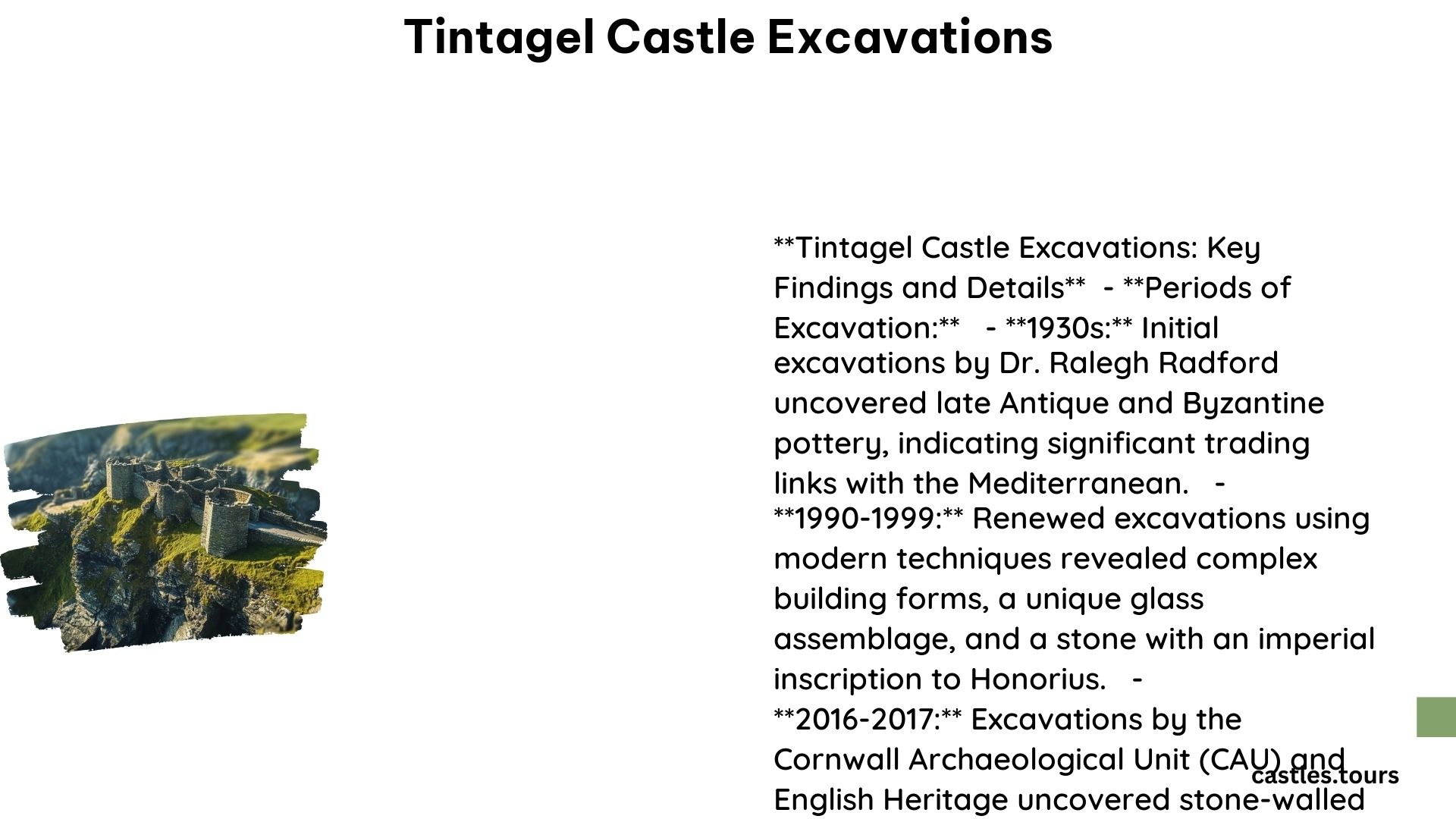The excavations at Tintagel Castle in Cornwall, UK, have been a source of fascination for archaeologists and historians alike, revealing the rich history and cultural significance of this legendary site. From the discovery of Mediterranean pottery to the unearthing of unique glass assemblages, the Tintagel Castle Excavations have shed light on the site’s role in the late Antique and early medieval periods.
What were the Key Findings of the Tintagel Castle Excavations?

 , licensed under CC BY-SA 2.0
, licensed under CC BY-SA 2.0The excavations conducted between 1990 and 1999 at Tintagel Castle were groundbreaking, uncovering a wealth of information about the site’s past. Some of the key findings include:
-
Building Forms and Occupation: The excavations, led by Rachel C. Barrowman, Colleen E. Batey, and Christopher D. Morris, used modern archaeological techniques to investigate the site, revealing the complexity and variability of building forms and associated occupation, highlighting Tintagel’s importance in the economy of the late Antique and Byzantine world.
-
Ceramic Assemblage: The excavations uncovered an extensive ceramic assemblage, including eastern Mediterranean and North African pottery, indicating wide-ranging connections during the fifth to seventh centuries.
-
Unique Glass Assemblage: A unique glass assemblage was discovered, along with a stone bearing a probable imperial inscription to Honorius, and graffiti by post-Roman individuals such as Paternus, Coliavus, and Artognou. These finds provided dramatic testimony to the cultural and literary milieu of high-status Dumnonian society in the post-Roman period.
-
The ‘Great Ditch’: The re-examination of the ‘Great Ditch’ established it as the largest promontory or hill-top site of its period, marking the boundary of a high-status settlement from the fifth to sixth centuries.
What is the Significance of the ‘Great Ditch’ at Tintagel Castle?

The ‘Great Ditch’ at Tintagel Castle is a significant feature of the site, as it marks the boundary of a high-status settlement from the fifth to sixth centuries. It is the largest promontory or hill-top site of its period, indicating the importance and scale of the settlement during the late Antique and early medieval periods.
What Types of Pottery and Artifacts were Found at Tintagel Castle?
The excavations at Tintagel Castle have yielded a variety of pottery and artifacts, including:
- Mediterranean Pottery: Significant volumes of eastern Mediterranean and North African pottery, dating from the fifth to seventh centuries, were found. This includes fine tableware from Turkey and amphorae from southern Turkey or Cyprus.
- Glassware: Fine glass fragments, including decorated Spanish glassware, were discovered, suggesting extensive trading links with the Mediterranean world.
- Other Artifacts: Iron artifacts such as personal wear, domestic items, and possible hunting paraphernalia were also uncovered, providing insights into domestic life during the late Roman and post-Roman periods.
What were the Recent Discoveries at Tintagel Castle?
The excavations conducted in 2016 and 2017 by the Cornwall Archaeological Unit have continued to uncover new and exciting discoveries at Tintagel Castle:
- New Discoveries: Excavations uncovered substantial stone walls, slate floors, and steps on the southern terrace of the castle. These finds included fine Phocaean Red Slipped Ware bowls from Turkey, imported wares, and Spanish glassware.
- Diet and Lifestyle: Evidence of a rich diet was found, including oyster shells, pig, cow, and sheep or goat bones, and a cod cranial bone, indicating deep sea fishing.
- Continued Research: The Tintagel Castle Archaeological Research Project, funded by English Heritage, continued with further excavations in 2017, focusing on promising areas identified in previous digs.
What Information is Available for Visitors to Tintagel Castle?
Tintagel Castle is a popular tourist destination, and visitors can learn more about the site and its excavations:
- Location: Tintagel Castle is located on the peninsula of Tintagel Island, adjacent to the village of Tintagel in North Cornwall, UK.
- Ownership and Management: The castle is owned by the Duchy of Cornwall but managed by English Heritage.
- Visiting Hours and Events: The site is open to visitors, with various events and festivals, such as the Archaeology Festival, which took place in 2017.
- Accessibility: Visitors can see ongoing excavations and participate in outreach programs during certain periods.
The Tintagel Castle Excavations have been a treasure trove of information, shedding light on the site’s rich history and cultural significance. From the discovery of Mediterranean pottery to the unearthing of unique glass assemblages, these excavations have captivated archaeologists and historians alike, and continue to provide valuable insights into the past.
References:
- Barrowman, R. C., Batey, C. E., & Morris, C. D. (2007). Excavations at Tintagel Castle, Cornwall, 1990-1999. Reports of the Research Committee of the Society of Antiquaries of London, 74. London: Society of Antiquaries of London. [DOI: 10.26530/20.500.12657/50366]
- English Heritage. (n.d.). Research on Tintagel Castle. Retrieved from https://www.english-heritage.org.uk/visit/places/tintagel-castle/history-and-legend/history/research/
- English Heritage. (2017, July 13). A feast of finds uncovered at Tintagel Castle. Retrieved from https://www.english-heritage.org.uk/about-us/search-news/tintagel-archaeology-report/
